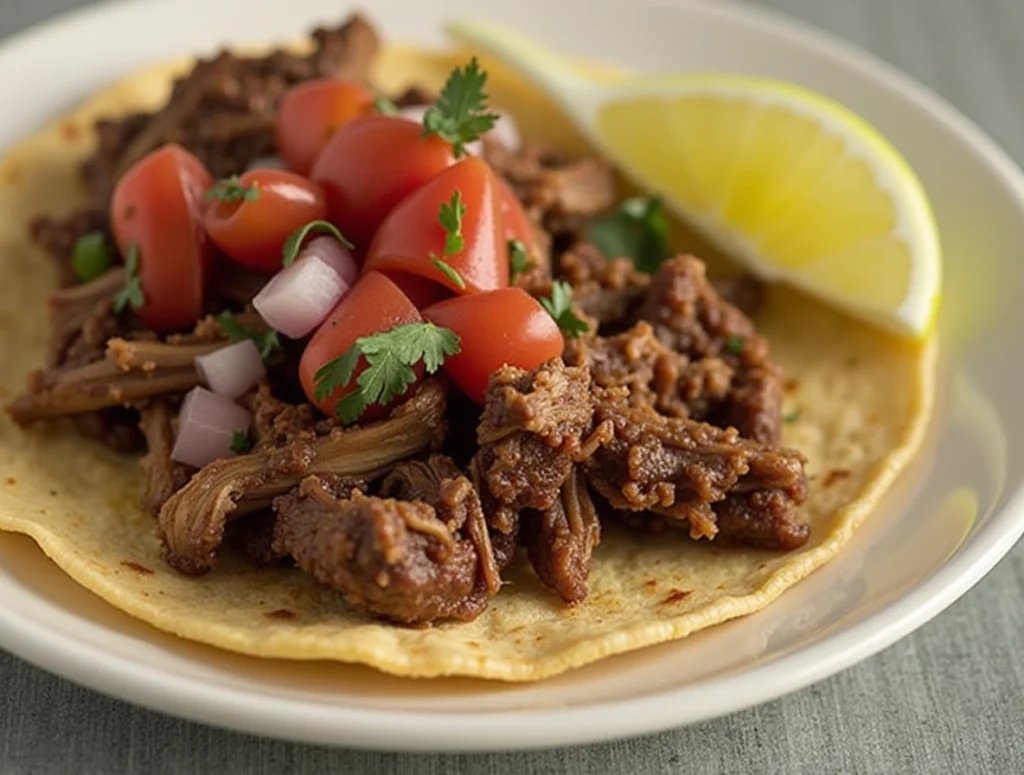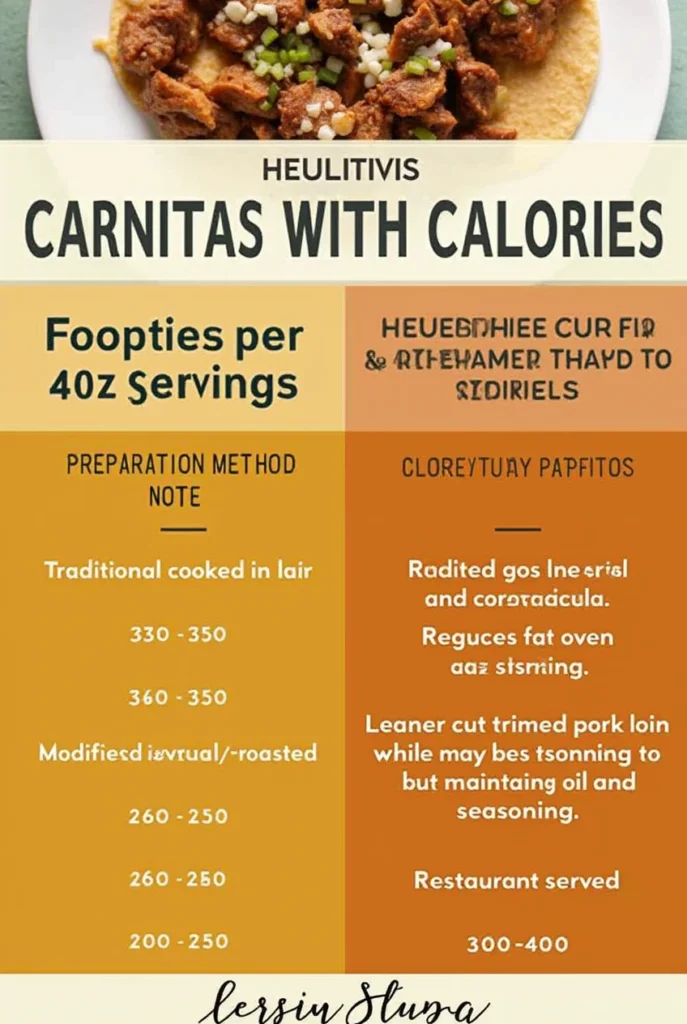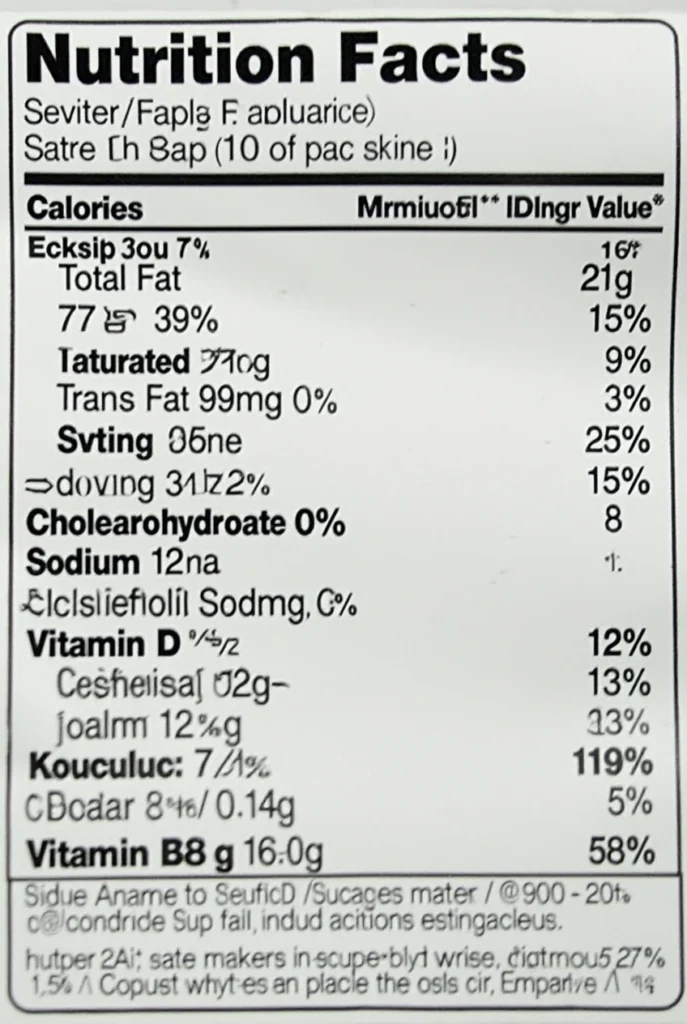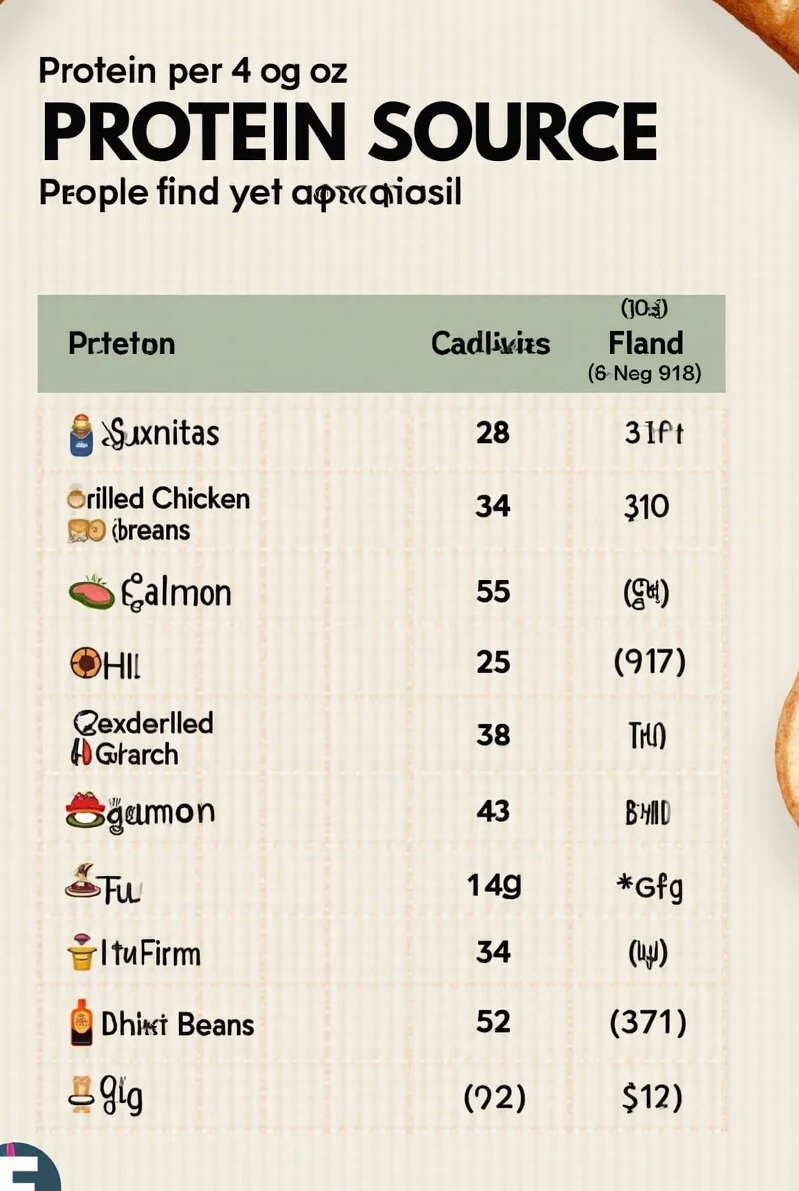By Chef HAMZA | Last Updated: May 2, 2025

Carnitas Nutrition: Complete Guide to Calories, Protein, and Making it Healthier
As a chef with nearly thirty years of experience crafting and perfecting recipes from around the world, I’ve developed an appreciation and deep understanding of Mexican cuisine—particularly carnitas. This succulent, slow-cooked pork dish has captured food lovers’ hearts (and stomachs). Still, many of my readers ask, “How many calories are in a serving of carnitas?”
Whether tracking your macros, managing your weight, or simply curious about what goes into your favorite taco filling, understanding carnitas nutrition is essential for making informed dietary choices. In this comprehensive guide, I’ll explain everything you need to know about carnitas calories, protein content, and how to enjoy this delicious dish as part of a balanced diet.
What You’ll Learn in This Article
- The exact calorie count in a standard serving of carnitas
- Complete nutritional breakdown, including protein, fat, and carbohydrates
- Regional variations and how they affect nutritional content
- Simple ways to create healthier carnitas without sacrificing flavor
- Expert tips for portion control and balanced meal planning with carnitas
- Answers to frequently asked questions about carnitas nutrition
Let’s dive into the flavorful world of carnitas while keeping our nutritional knowledge sharp!
What Are Carnitas nutrition? Understanding the Basics
Before we analyze the nutritional profile, it’s important to understand what carnitas are. The term “carnitas” translates to “little meats” in Spanish and refers to a Mexican dish of seasoned pork slow-cooked until tender, then typically finished with high heat to create crispy, caramelized edges.
Traditional carnitas originated in the state of Michoacán, Mexico, where the pork (usually shoulder or butt) is simmered in lard with herbs and spices until it achieves that perfect balance of tender interior and crispy exterior. The cooking method and ingredients significantly impact the final nutritional profile of carnitas.
Carnitas nutrition Calories: Breaking Down the Numbers

Let’s address the central question: how many calories are in a serving of carnitas?
A standard 4-ounce (113g) serving of traditional carnitas contains approximately 290-320 calories. However, this number can vary significantly based on several factors:
| Preparation Method | Calories per 4oz Serving | Notes |
|---|---|---|
| Traditional (cooked in lard) | 320-350 | Highest calorie option due to fat absorption |
| Modern (oven-roasted) | 260-290 | Reduced fat while maintaining flavor |
| Leaner cut (trimmed pork loin) | 220-250 | Lower in fat but may be less tender |
| Restaurant-served | 300-400 | Often higher due to additional oil and seasonings |
It’s worth noting that these calorie counts represent the meat alone. When carnitas are served in tacos, burritos, or with sides, the total caloric content increases accordingly. For example:
- Two street-style carnitas tacos with corn tortillas: 450-500 calories
- Carnitas burrito with rice and beans: 650-800 calories
- Carnitas plate with rice, beans, and tortillas: 800-1000 calories
Where Do These Calories Come From?
The caloric content of carnitas comes primarily from two macronutrients:
- Protein: Approximately 40% of calories
- Fat: Approximately 60% of calories
Carnitas contain minimal carbohydrates, although traditional recipes may include small amounts of orange juice or other ingredients that add trace carbohydrates.
Complete Carnitas Nutritional Profile of Carnitas

Understanding the full nutritional breakdown of carnitas helps you better incorporate this delicious protein into a balanced diet. Here’s what you’ll find in a standard 4-ounce serving of traditional carnitas:
| Calories | 310 | 15.5% |
| Total Fat | 21g | 27% |
| Saturated Fat | 7.5g | 37.5% |
| Trans Fat | 0g | – |
| Cholesterol | 95mg | 32% |
| Sodium | 290mg | 12.6% |
| Total Carbohydrates | 0-2g | 0-1% |
| Dietary Fiber | 0g | 0% |
| Sugars | 0-1g | – |
| Protein | 28g | 56% |
| Vitamin D | 4% | – |
| Calcium | 2% | – |
| Iron | 8% | – |
| Potassium | 12% | – |
| Zinc | 22% | – |
| Vitamin B12 | 18% | – |
*Percent Daily Values based on a 2,000-calorie diet
As you can see, carnitas are particularly rich in protein, making them a valuable option for those focused on protein intake. However, they’re also relatively high in saturated fat, which should be considered when planning balanced meals.
Carnitas Protein Content: A High-Quality Source
One of the nutritional highlights of carnitas is its impressive protein content. With approximately 28 grams of protein per 4-ounce serving, carnitas can contribute significantly to your daily protein needs.
Pork is a complete protein source, containing all nine essential amino acids our bodies cannot produce independently. These amino acids are crucial for:
- Muscle repair and growth
- Immune system function
- Hormone production
- Enzyme activity
- Overall cellular health
The protein in carnitas is highly bioavailable, making it an efficient source of these essential nutrients. For active individuals or those looking to increase their protein intake, carnitas can be a flavorful addition to a balanced diet.
How Carnitas Protein Compares to Other Protein Sources

| Protein Source | Protein per 4 oz | Calories per 4 oz |
|---|---|---|
| Carnitas | 28g | 310 |
| Grilled Chicken Breast | 35g | 187 |
| Salmon | 25g | 233 |
| Tofu (Firm) | 14g | 166 |
| Black Beans | 9g | 91 |
While carnitas offer substantial protein, they have more calories than leaner options like chicken breast. However, when portion sizes are managed appropriately, they can still be part of a balanced diet.
Carnitas Fat Content: Understanding the Types of Fat
The fat content in carnitas deserves special attention, as it significantly contributes to calorie count and flavor. A 4-ounce serving contains approximately 21 grams of total fat, which breaks down to:
- Saturated fat: 7.5g (38% of total fat)
- Monounsaturated fat: 9g (43% of total fat)
- Polyunsaturated fat: 4g (19% of total fat)
While saturated fat is traditionally associated with cardiovascular concerns, more recent research suggests a more nuanced understanding. The monounsaturated fats in pork (similar to those in olive oil) may have heart-healthy properties.
The American Heart Association still recommends limiting saturated fat intake to less than 10% of daily calories, so moderation remains essential.
Regional Variations in Carnitas nutrition and Their Nutritional Impact
Different regions of Mexico (and beyond) prepare carnitas with unique techniques and ingredients, affecting the nutritional profile:
Michoacán-Style Carnitas
The traditional preparation from this Mexican state involves simmering pork in lard with oranges, milk, and spices. This method results in:
- Higher fat content (23-25g per 4oz)
- Slightly higher calorie count (330-350 per 4oz)
- Complex flavor development from fat-soluble compounds
Jalisco-Style Carnitas
Often prepared with beer and less lard, this variation typically has:
- Moderate fat content (18-20g per 4oz)
- Fewer calories (280-300 per 4oz)
- Unique flavor notes from the beer reduction
American-Adapted Carnitas
Common in the US, this version often uses slow cookers or pressure cookers with minimal added fat:
- Lower fat content (13-16g per 4oz)
- Reduced calories (240-270 per 4oz)
- It often incorporates additional seasonings like cumin and oregano.
Check out our comparison of smoked carnitas vs. traditional methods.
Healthier Carnitas nutrition : Reducing Calories While Maintaining Flavor
As a chef who values both flavor and nutrition, I’ve developed several techniques for creating healthier carnitas without sacrificing the taste experience:
1. Alternative Cooking Methods
Instead of the traditional method of cooking in lard, consider these healthier approaches:
- Oven-roasting: Season pork shoulder, add minimal oil, cover, and slow-roast at 300°F (150°C) for 3-4 hours, then uncover and increase heat to crisp.
- Slow cooker: Add pork with aromatics, citrus, and just a tablespoon of oil, cook on low for 8 hours, then broil briefly to crisp edges.
- Pressure cooker/Instant Pot: Cook seasoned pork with minimal fat and some liquid (broth/citrus juice) for 45-60 minutes, then broil for texture.
These methods can reduce fat content by 30-40% while preserving the tender texture and rich flavor profile.
2. Leaner Cut Selection
Traditional carnitas use pork shoulder (Boston butt), which has excellent marbling but higher fat content. For a leaner option:
- Pork loin: Offers approximately 40% less fat than shoulder, though it requires careful cooking to prevent dryness.
- Trimmed pork shoulder: Removing visible fat before cooking can reduce fat content by 15-20%.
3. Flavor-Boosting Ingredients
Replace some of the fat-derived flavor with these powerhouse ingredients:
- Citrus zest and juice (orange, lime)
- Toasted and ground spices (cumin, coriander, Mexican oregano)
- Chipotle peppers in adobo sauce
- Fresh herbs (cilantro, epazote)
- Garlic and onion confit (slow-cooked in minimal oil)
4. The “Drain and Crisp” Technique
This two-stage cooking method significantly reduces fat while maintaining texture:
- Slow-cook the pork with seasonings and minimal added fat
- After cooking, drain and reserve the accumulated fat and juices
- Return only a small amount of the reserved liquid to the meat
- Crisp under the broiler or in a hot skillet
This technique can reduce fat content by up to 45% compared to traditional methods.
Carnitas nutrition in a Balanced Diet: Practical Tips
Carnitas can be part of a healthy, balanced diet when approached thoughtfully:
Portion Control
- Standard serving size: 3-4 ounces (about the size of a deck of cards)
- Use a kitchen scale initially to train your eye
- Fill the majority of your plate with vegetables and whole grains
Creating Balanced Meals with Carnitas
Sample Balanced Meal Plans:
- Carnitas Taco Bowl
- 3oz carnitas (240 calories)
- 1/2 cup black beans (120 calories)
- 1/2 cup brown rice (108 calories)
- 2 cups mixed vegetables (70 calories)
- 1/4 avocado (80 calories)
- Salsa, lime, cilantro (15 calories)
- Total: ~633 calories with an excellent macro balance
- Carnitas Lettuce Wraps
- 3oz carnitas (240 calories)
- 4 large romaine lettuce leaves (20 calories)
- 1/4 cup pico de gallo (20 calories)
- 2 tablespoons Greek yogurt (25 calories)
- 1/4 cup pickled red onions (15 calories)
- Small side of roasted sweet potato (100 calories)
- Total: ~420 calories, lower-carb option
Frequency Considerations
As with many higher-fat protein sources, moderation is key:
- For general healthy eating: Enjoy carnitas 1-2 times per week
- For specific weight loss goals, Limit to once weekly and control portion size
- For athletic performance: May include more frequently when paired with complex carbs and vegetables for recovery meals
Special Dietary Considerations
Carnitas for Keto and Low-Carb Diets
Traditional carnitas are naturally low in carbohydrates, making them suitable for ketogenic and low-carb dietary approaches. A 4-ounce serving contains:
- 0-2g carbohydrates
- 28g protein
- 21g fat
- Total: 310 calories
This macronutrient ratio (approximately 75% calories from fat, 24% from protein, and 1% from carbs) aligns well with ketogenic dietary guidelines.
Serving suggestions for keto/low-carb diets:
- Over cauliflower rice
- In lettuce wraps
- With a side of avocado and vegetables
- In a low-carb tortilla (count the additional carbs)
Carnitas for High-Protein Diets
For those following high-protein diets for muscle building or recovery, carnitas provide substantial protein with the added benefit of flavor diversity. Consider:
- Pairing with egg whites for a protein-packed breakfast
- Adding to a post-workout meal with sweet potatoes for glycogen replenishment
- Including meal prep containers with vegetables and healthy fats
Carnitas for Those Watching Sodium Intake
Traditional carnitas recipes can be high in sodium, with some preparations containing 400-500mg per 4-ounce serving. To reduce sodium:
- Use freshly ground spices instead of pre-made seasoning blends
- Reduce added salt and enhance flavor with acids (citrus juice, vinegar)
- Choose low-sodium broth if using liquid in the cooking process
- Season primarily with herbs rather than salt
The Science Behind Carnitas Nutrition
Understanding the scientific aspects of carnitas nutrition can help you make informed decisions about including this dish in your diet.
Protein Quality and Digestibility
Pork protein has a high Protein Digestibility Corrected Amino Acid Score (PDCAAS) of approximately 0.92 (out of 1.0), indicating excellent bioavailability. This means your body can efficiently use the protein from carnitas for tissue repair and muscle synthesis.
Thermal Effect of Protein
Protein requires more energy to digest than carbohydrates or fats—approximately 20-30% of the calories in protein are used during digestion and processing. This “thermic effect” means high-protein foods like carnitas may support metabolic rate.
Satiety Impact
The combination of protein and fat in carnitas contributes to strong satiety signals, potentially reducing overall calorie intake at subsequent meals. Research suggests that meals containing 25-30g of protein (similar to a serving of carnitas) significantly increase feelings of fullness compared to lower-protein meals.
Learn more about the caloric content of carnitas per Serving.
Restaurant vs. Homemade Carnitas nutrition : Nutritional Differences
The nutritional profile of carnitas can vary significantly depending on whether they’re prepared at home or in a restaurant setting.
Restaurant Carnitas
Restaurant carnitas often feature:
- Larger portion sizes (typically 6-8oz per Serving)
- Higher fat content due to traditional preparation methods
- Additional sodium for flavor enhancement
- Potential use of flavor additives or preservatives
A restaurant portion of carnitas can contain 450-650 calories, 28-40g of fat, and 800-1200mg of sodium.
Homemade Carnitas
When prepared at home, you have greater control over:
- Portion sizes
- Cut selection and fat-trimming
- Cooking methods and added fats
- Sodium and seasoning levels
- Quality of Ingredients
My recommended home preparation methods can reduce the calorie content by 25-35% compared to restaurant versions while maintaining excellent flavor profiles.
According to a study published in the Journal of Food Science, home-prepared meals typically contain 60-70% of the calories of their restaurant counterparts due to these factors.
Carnitas Nutrition for Special Populations
Athletes and Active Individuals
For those with high energy expenditure and muscle recovery needs:
- Carnitas provide the necessary protein for muscle repair
- The fat content supports hormone production
- Consider timing carnitas meals post-workout for optimal recovery
- Pair with complex carbohydrates to replenish glycogen stores
Weight Management Goals
If you’re focused on weight loss or maintenance:
- Control portion sizes (3-4oz maximum)
- Use leaner preparation methods
- Emphasize vegetable pairings
- Consider the caloric density when planning daily intake
- Utilize the protein content to support satiety and muscle preservation
Older Adults
For aging populations with increased protein needs:
- Carnitas offer easily chewable, flavor-rich protein
- The caloric density can support those with decreased appetite
- The complete amino acid profile supports muscle maintenance
- The zinc content (22% DV) supports immune function
How to Make the Most of Your Carnitas nutrition in a Torta
Common Questions About Carnitas Nutrition
How Many Calories Are in Carnitas Compared to Other Taco Fillings?
| Taco Filling (4 oz) | Calories | Protein | Fat |
|---|---|---|---|
| Carnitas | 310 | 28g | 21g |
| Grilled Chicken | 187 | 35g | 4g |
| Ground Beef (80/20) | 290 | 23g | 22g |
| Fish (Grilled) | 160 | 31g | 3g |
| Sofritas (Tofu) | 145 | 15g | 8g |
| Barbacoa | 240 | 24g | 15g |
While carnitas are higher in calories than some alternatives, they offer excellent protein content and unique flavor profiles that may increase meal satisfaction.
Is There a Significant Nutritional Difference Between Various Cuts Used for Carnitas?
Yes, the cut of pork significantly impacts the nutritional profile:
- Pork shoulder (traditional): 310 calories, 21g fat, 28g protein per 4oz
- Pork loin (leaner): 240 calories, 12g fat, 32g protein per 4oz
- Pork belly (fattier): 480 calories, 43g fat, 15g protein per 4oz
The choice of cut should align with your specific nutritional goals.
Can Carnitas Be Part of a Heart-Healthy Diet?
With modifications, carnitas can fit into a heart-conscious eating pattern:
- Use leaner cuts and trimming techniques
- Employ healthier cooking methods (oven-roasting, slow cooking)
- Control portion sizes
- Include heart-healthy sides like beans, avocado, and vegetables
- Consider frequency (occasional rather than daily consumption)
The American Heart Association suggests limiting saturated fat to 13g daily for a 2,000-calorie diet, so a serving of carnitas would represent approximately 55% of this limit.
How Should I Adjust Portion Sizes Based on My Caloric Needs?
For a 2,000-calorie diet:
- Standard portion: 3-4oz (240-310 calories)
For a 1,500-calorie diet:
- Reduced portion: 2-3oz (160-240 calories)
For a 2,500+ calorie diet (active individuals):
- Larger portion: 4-5oz (310-390 calories)
Always consider the context of the complete meal and adjust accordingly.
What’s the Best Way to Reheat Costco Carnitas While Preserving Nutrition?
Healthy Carnitas nutrition Recipe: My Chef’s Take on Lighter Carnitas
As promised, here’s my recipe for creating more nutritionally balanced carnitas without sacrificing flavor:
Oven-Roasted Citrus Carnitas (Reduced Fat Version)
Ingredients:
- 3 pounds pork loin (trimmed of visible fat), cut into 2-inch cubes
- 2 tablespoons olive oil
- 4 cloves garlic, minced
- 1 tablespoon ground cumin
- 2 teaspoons dried oregano (preferably Mexican)
- 1 teaspoon ground coriander
- 1 teaspoon smoked paprika
- 1 teaspoon sea salt
- 1/2 teaspoon freshly ground black pepper
- 2 oranges, juiced and zested
- 2 limes, juiced and zested
- 1 cup low-sodium chicken broth
- 1 cinnamon stick
- 2 bay leaves
- 1 onion, quartered
Method:
- Preheat oven to 325°F (165°C).
- Heat one tablespoon olive oil over medium-high heat in a large Dutch oven.
- In batches, brown the pork pieces on all sides (about 2-3 minutes per batch). Set aside.
- Add remaining oil and sauté garlic until fragrant (30 seconds).
- Return pork to the pot, add all seasonings, citrus juice and zest, broth, cinnamon stick, bay leaves, and onion.
- Cover tightly and transfer to oven. Roast for 2.5-3 hours until meat is fork-tender.
- Remove from oven, discard the cinnamon stick and bay leaves.
- Transfer meat to a baking sheet and shred slightly with two forks.
- Strain the cooking liquid, skim off excess fat, and reduce by half in a saucepan.
- Drizzle 1/2 cup of reduced liquid over the meat.
- Increase oven temperature to 450°F (230°C) and roast uncovered for 15-20 minutes until edges are crispy.
Nutritional Information Per 4oz Serving:
- Calories: 240
- Protein: 31g
- Fat: 12g
- Saturated Fat: 3.5g
- Carbohydrates: 3g
- Sodium: 240mg
This represents a 23% reduction in calories and a 43% reduction in fat compared to traditional carnitas while maintaining excellent flavor and texture.
Understanding Carnitas in Context: The Complete Mexican Diet
Traditional Mexican cuisine—recognized by UNESCO as an Intangible Cultural Heritage of Humanity—offers valuable lessons in dietary balance. When examining carnitas in their cultural context, we gain insights into healthful eating patterns:
- Portion Perspective: Traditional Mexican meals typically feature meat as a flavor component rather than the main volume of the meal
- Accompaniments: Fresh salsas, vegetables, beans, and whole grains provide fiber, vitamins, and minerals
- Nutrient Density: The combination of protein, complex carbohydrates, and healthy fats creates well-rounded nutrition
- Culinary Techniques: Methods like slow cooking and using spices for flavor minimize the need for excessive added fats
According to research from Harvard T.H. Chan School of Public Health, traditional cooking methods and food combinations often inherently align with modern nutritional guidelines.
Quick Takeaways: Carnitas Nutrition Summary
- A standard 4-ounce serving of traditional carnitas contains approximately 310 calories
- Carnitas are an excellent source of complete protein, offering about 28g per Serving
- The fat content (21g per Serving) contributes significantly to the caloric value but also to flavor satisfaction
- Cooking methods can dramatically impact the nutritional profile, with potential calorie reductions of 20-30%
- Portion control is essential—limit servings to 3-4 ounces when managing calorie intake
- Balanced meals should include carnitas as a component alongside vegetables, beans, and moderate amounts of grains
- Homemade carnitas allow for greater nutritional control compared to restaurant versions
Final Thoughts on Enjoying Carnitas as Part of a Balanced Diet
As a chef who believes in both the pleasure and nutrition of food, I advocate for a balanced approach to enjoying dishes like carnitas. The key is mindful consumption: savor this flavorful protein in appropriate portions, pair it with nutrient-rich sides, and consider the preparation method.
Traditional foods like carnitas connect us to culinary heritage while providing sustenance. Rather than viewing them through a binary lens of “good” or “bad,” I encourage appreciating them as part of a varied diet that includes many different foods, flavors, and nutrients.
Remember that occasional indulgence in traditional preparation methods can be part of an overall healthy relationship with food. The goal isn’t perfection but rather a sustainable, enjoyable approach to eating that nourishes both body and soul.
By understanding the nutritional profile of carnitas and making informed choices about preparation and portions, you can continue to enjoy this delicious dish while supporting your health goals.
Frequently Asked Questions About Carnitas Nutrition
How many calories are in carnitas from popular restaurant chains?
The calorie content of restaurant carnitas varies widely:
Chipotle: 4oz serving contains approximately 210 calories
Qdoba: 4oz serving contains approximately 220 calories
Taco Bell (shredded pork): 4oz serving contains approximately 260 calories
Local Mexican restaurants: Typically 300-400 calories per 4oz serving
Always check specific restaurant nutrition information when available.
Is there a significant nutritional difference between pork shoulder and pork butt for carnitas?
Despite the name difference, pork shoulder and pork butt (Boston butt) are actually from the same primal cut of the pig. Pork butt comes from higher on the foreleg, contains slightly more intramuscular fat (marbling), and typically has 10-15% more calories than pork shoulder cuts from lower on the leg.
What are the best low-calorie accompaniments for carnitas?
For a nutritionally balanced meal that keeps calories in check, consider:
Jicama slaw with lime and cilantro (25 calories per cup)
Roasted vegetables like bell peppers and onions (45 calories per cup)
Cauliflower rice (25 calories per cup)
Fresh salsa or pico de gallo (20 calories per 1/4 cup)
Pickled red onions (15 calories per 1/4 cup)
How does the nutritional profile change when carnitas are crisped after cooking?
The crisping process (often done under a broiler or in a hot skillet) can:
Render out 2-4g of fat per 4oz serving, potentially reducing calories by 18-36
Slightly concentrate the protein content by removing moisture
Create flavor compounds through Maillard reaction that may increase satiety
Are there any notable micronutrients in carnitas?
Yes, carnitas provide several essential micronutrients:
Zinc: 22% DV per Serving (supports immune function)
B12: 18% DV per Serving (critical for nerve function and blood cell formation)
Iron: 8% DV per Serving (highly bioavailable heme iron)
Phosphorus: 20% DV per serving (important for bone health)
Selenium: 40% DV per Serving (potent antioxidant)
Chef HAMZA founded TheFoodNearMe blog, creating and perfecting recipes for over 28 years. With global cuisines and nutrition expertise, HAMZA brings culinary artistry and scientific understanding to his writing about food.
